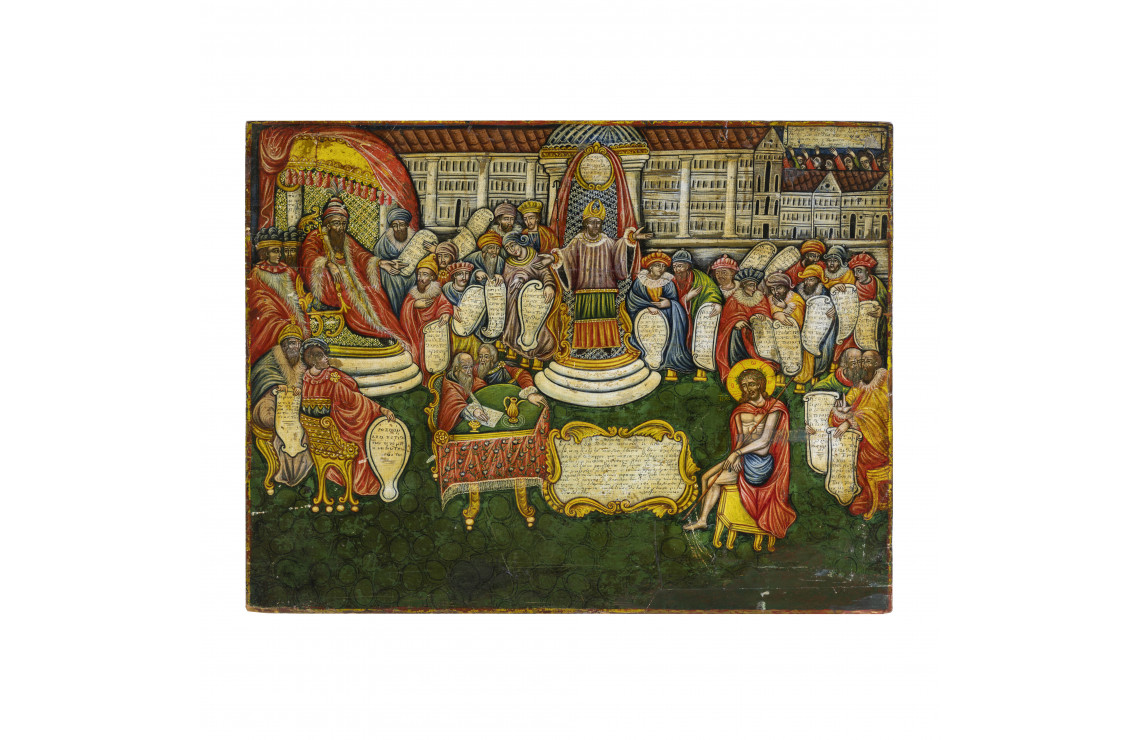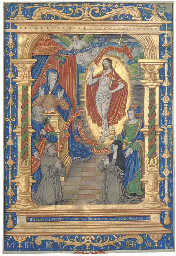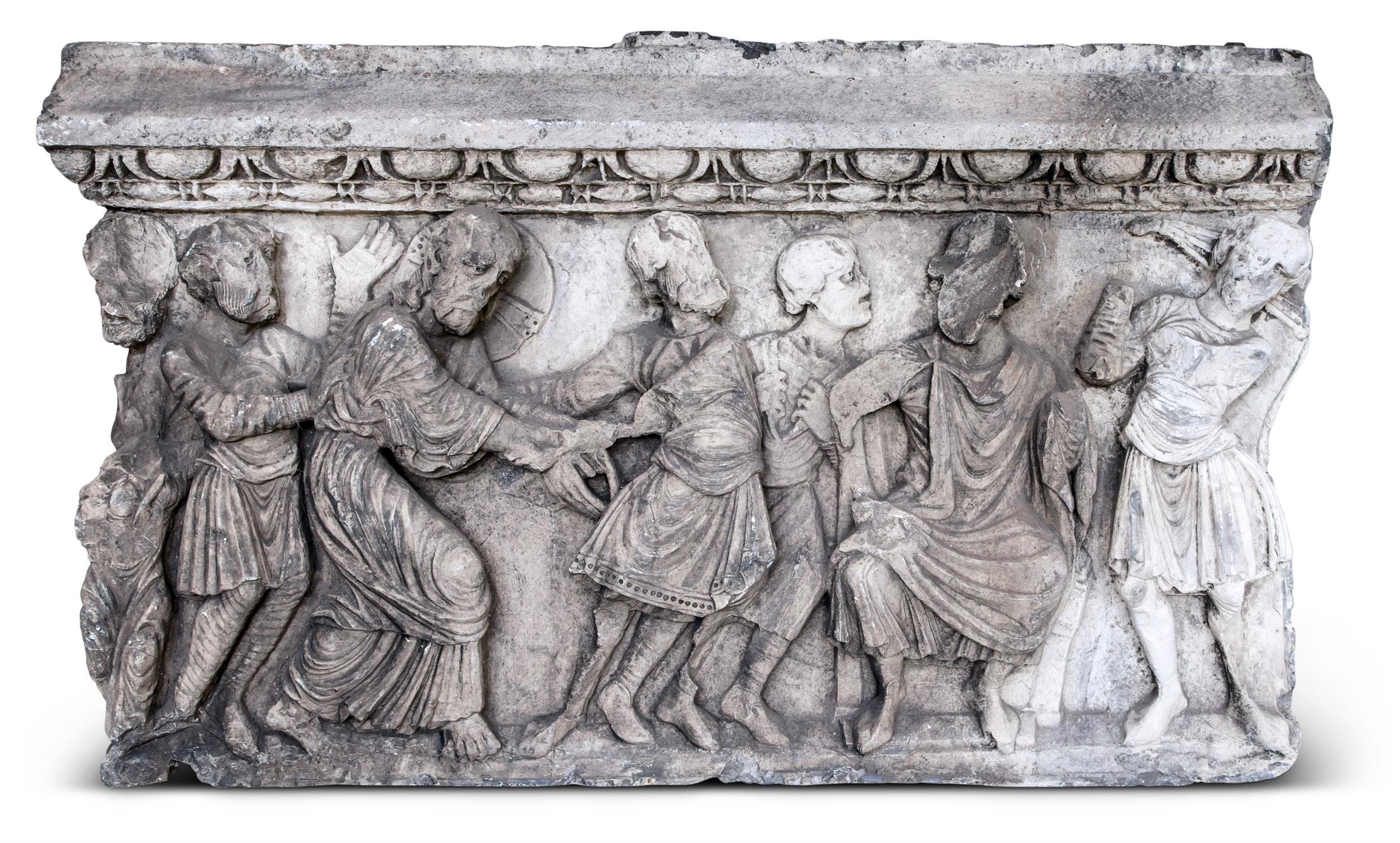CHRIST BEFORE THE HIGH PRIEST ANNAS, miniature in pen and wash on a recto cut from a Lectionary, in German, DECORATED MANUSCRIPT ON PAPER [Swabia, c.1470] 114 x 148mm. In a hall with views onto sky and landscape, Christ is surrounded by soldiers and servants of the High Priest, who is seated on a traceried chair at the left; on the verso, two columns of text written in brown ink in a cursive hand between four verticals and ?two horizontals (upper visible), ruled in brown, justification width: 144mm, text capitals touched red (slight smudging over unpainted margin). Framed, double-sided. The text on the verso, opening Ihus sprach Ich haun offenlich der welt geredet... , is a translation into a Swabian dialect of John 18, 20 (Jesus answered him: I have spoken openly to the world). The complete manuscript was a Lectionary, since the reverse of a miniature of the Stoning of Stephen, cut from the same book, has rubrics for the Gospel reading for the feast of St Stephen and for the Epistle reading for St John. The manuscript had been broken-up by the mid-19th century when the St Stephen miniature was in the vast collection assembled by Michele Cavaleri in Milan. This miniature is a very fresh and unfaded example of the pen-and-wash technique favoured for illustrating manuscripts on paper. The taut pen lines give a vibrant energy to the figures, reinforced by the rapid and effective painting. The coloured washes are applied to leave dramatic highlights of exposed white paper so that the figures have a rounded solidity and plausibility. Designed as an interlocking group, the characters also relate through their expressions and gestures, created by deft strokes of extreme economy. The servant striking Christ identifies the High Priest as Annas, as related in John 18, 22. The style as well as dialect locate the manuscript to Swabia, where there was a thriving market for illustrated books on paper (see H. Lehmann-Haupt, Schwäbische Federzeichnungen: Studien zur Buchillustration Augsburgs im Xv. Jahrhudert , 1929). These were generally secular romances or chronicles, such as the Augsburg Chronicle of which at least five illustrated copies are known dating from 1457-c.1490 (N. Ott, 'Frühe Augsburger Buchillustration', pp.201-241 in Augsburger Buchdruck und Verlagswesen , H. Gier and J. Janota eds, 1997, pp.219-25). Books used in the liturgy were in Latin and usually on vellum: this Lectionary was presumably made for a lay person to follow or study the liturgical readings, with the instant comprehensibility of the vernacular text matched by the immediacy of the vivid pictures. This desire for full participation in church ritual would be a contributary factor in the Reformation. PROVENANCE: Christie's, London, 11 July 1974, lot 1; Voelkle and Wieck, no 40. RELATED LEAF: Stoning of St Stephen, Hamburg, Dr Jörn Günther, Ms 28.
CHRIST BEFORE THE HIGH PRIEST ANNAS, miniature in pen and wash on a recto cut from a Lectionary, in German, DECORATED MANUSCRIPT ON PAPER [Swabia, c.1470] 114 x 148mm. In a hall with views onto sky and landscape, Christ is surrounded by soldiers and servants of the High Priest, who is seated on a traceried chair at the left; on the verso, two columns of text written in brown ink in a cursive hand between four verticals and ?two horizontals (upper visible), ruled in brown, justification width: 144mm, text capitals touched red (slight smudging over unpainted margin). Framed, double-sided. The text on the verso, opening Ihus sprach Ich haun offenlich der welt geredet... , is a translation into a Swabian dialect of John 18, 20 (Jesus answered him: I have spoken openly to the world). The complete manuscript was a Lectionary, since the reverse of a miniature of the Stoning of Stephen, cut from the same book, has rubrics for the Gospel reading for the feast of St Stephen and for the Epistle reading for St John. The manuscript had been broken-up by the mid-19th century when the St Stephen miniature was in the vast collection assembled by Michele Cavaleri in Milan. This miniature is a very fresh and unfaded example of the pen-and-wash technique favoured for illustrating manuscripts on paper. The taut pen lines give a vibrant energy to the figures, reinforced by the rapid and effective painting. The coloured washes are applied to leave dramatic highlights of exposed white paper so that the figures have a rounded solidity and plausibility. Designed as an interlocking group, the characters also relate through their expressions and gestures, created by deft strokes of extreme economy. The servant striking Christ identifies the High Priest as Annas, as related in John 18, 22. The style as well as dialect locate the manuscript to Swabia, where there was a thriving market for illustrated books on paper (see H. Lehmann-Haupt, Schwäbische Federzeichnungen: Studien zur Buchillustration Augsburgs im Xv. Jahrhudert , 1929). These were generally secular romances or chronicles, such as the Augsburg Chronicle of which at least five illustrated copies are known dating from 1457-c.1490 (N. Ott, 'Frühe Augsburger Buchillustration', pp.201-241 in Augsburger Buchdruck und Verlagswesen , H. Gier and J. Janota eds, 1997, pp.219-25). Books used in the liturgy were in Latin and usually on vellum: this Lectionary was presumably made for a lay person to follow or study the liturgical readings, with the instant comprehensibility of the vernacular text matched by the immediacy of the vivid pictures. This desire for full participation in church ritual would be a contributary factor in the Reformation. PROVENANCE: Christie's, London, 11 July 1974, lot 1; Voelkle and Wieck, no 40. RELATED LEAF: Stoning of St Stephen, Hamburg, Dr Jörn Günther, Ms 28.





.jpg)









Testen Sie LotSearch und seine Premium-Features 7 Tage - ohne Kosten!
Lassen Sie sich automatisch über neue Objekte in kommenden Auktionen benachrichtigen.
Suchauftrag anlegen